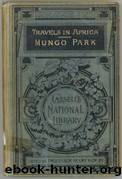Travels in the Interior of Africa â Volume 02 by Mungo Park

Author:Mungo Park [Park, Mungo]
Language: eng
Format: epub
ISBN: 9781546675990
Google: u8-ptAEACAAJ
Publisher: CreateSpace Independent Publishing Platform
Published: 2017-05-14T03:01:17+00:00
CHAPTER XXIII.
GOLD AND IVORY.
Those valuable commodities, gold and ivory (the next objects of our inquiry), have probably been found in Africa from the first ages of the world. They are reckoned among its most important productions in the earliest records of its history.
It has been observed that gold is seldom or never discovered except in mountainous and barren countriesânature, it is said, thus making amends in one way for her penuriousness in the other. This, however, is not wholly true. Gold is found in considerable quantities throughout every part of Manding, a country which is indeed hilly, but cannot properly be called mountainous, much less barren. It is also found in great plenty in Jallonkadoo (particularly about Boori), another hilly, but by no means an unfertile, country. It is remarkable that in the place last mentioned (Boori), which is situated about four daysâ journey to the south-west of Kamalia, the salt market is often supplied at the same time with rock-salt from the Great Desert and sea-salt from the Rio Grande; the price of each, at this distance from its source, being nearly the same. And the dealers in each, whether Moors from the north or negroes from the west, are invited thither by the same motivesâthat of bartering their salt for gold.
The gold of Manding, so far as I could learn, is never found in any matrix or vein, but always in small grains nearly in a pure state, from the size of a pinâs head to that of a pea, scattered through a large body of sand or clay, and in this state it is called by the Mandingoes sanoo munko (gold powder). It is, however, extremely probable, by what I could learn of the situation of the ground, that most of it has originally been washed down by repeated torrents from the neighbouring hills. The manner in which it is collected is nearly as follows:â
About the beginning of December, when the harvest is over and the streams and torrents have greatly subsided, the mansa or chief of the town appoints a day to begin sanoo koo (gold-washing), and the women are sure to have themselves in readiness by the time appointed. A hoe or spade for digging up the sand, two or three calabashes for washing it in, and a few quills for containing the gold dust, are all the implements necessary for the purpose. On the morning of their departure a bullock is killed for the first dayâs entertainment, and a number of prayers and charms are used to insure success, for a failure on that day is thought a bad omen.
The mansa of Kamalia, with fourteen of his people, were, I remember, so much disappointed in their first dayâs washing that very few of them had resolution to persevere, and the few that did had but very indifferent success: which indeed is not much to be wondered at, for instead of opening some untried place they continued to dig and wash in the same spot where they had dug and washed for years, and where, of course, but few large grains could be left.
Download
This site does not store any files on its server. We only index and link to content provided by other sites. Please contact the content providers to delete copyright contents if any and email us, we'll remove relevant links or contents immediately.
Evelina by Fanny Burney(26795)
Evelina, Or, the History of a Young Lady's Entrance into the World by Fanny Burney(26231)
Twilight of the Idols With the Antichrist and Ecce Homo by Friedrich Nietzsche(18501)
Pale Blue Dot by Carl Sagan(4909)
The Perks of Being a Wallflower by Stephen Chbosky(4570)
Dune 01 Dune by Frank Herbert(4312)
Double Down (Diary of a Wimpy Kid Book 11) by Jeff Kinney(4206)
Man and His Symbols by Carl Gustav Jung(4066)
Walking by Henry David Thoreau(3892)
Separate Beds by LaVyrle Spencer(3769)
Ficciones by Jorge Luis Borges(3569)
FOUNDATION AND EMPIRE by Isaac Asimov(3548)
The 101 Dalmatians by Dodie Smith(3451)
Mystery at School by Laura Lee Hope(3369)
Anna and the French Kiss by Stephanie Perkins(3316)
120 Days of Sodom by Marquis de Sade(3177)
Some Prefer Nettles by Tanizaki Junichiro(2841)
The Little Prince by Antoine de Saint-Exupéry(2826)
My Ántonia by Willa Cather(2804)
